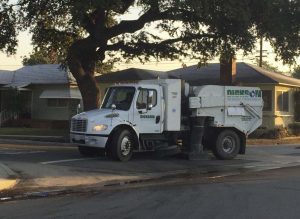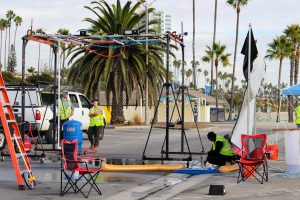Method developed to measure street sweeping’s effectiveness

SCCWRP and its partners have developed a novel method for quantifying the effectiveness of routine street sweeping in removing contaminants that would otherwise enter storm drains and contribute to runoff pollution – a study that moves managers one step closer to being able to understand street sweeping’s capacity to help protect runoff water quality.
The method, described in a SCCWRP technical report published in January, provides a feasible path forward for pursuing follow-up investigations that will shed light on what role street sweeping plays in reducing runoff pollution – and how managers might be able to optimize their routine street sweeping regimes.
As part of the method’s development, which took place over the course of a three-year Southern California Stormwater Monitoring Coalition (SMC) project, researchers tested the method at a single site, generating preliminary data suggesting street sweeping may provide more benefits for improving runoff water quality than traditionally assumed. Historically, nonstructural BMPs like street sweeping have been assumed to reduce contamination in runoff by 5-10%.
While the method development study was not designed to identify alternate values for the pollution removal efficiency of street sweeping, the SMC already is developing plans for a follow-up investigation that will measure these values with statistical confidence.
Municipalities commonly rely on street sweeping to remove debris that is unsightly and can clog storm drain systems, but what has historically been unclear is what portion of stormwater pollutants – sediment, nutrients, trace heavy metals, microplastics and bacteria – remain on roadways after street sweeping.
Under stormwater discharge permits, managers commonly receive a runoff pollution credit for implementing routine street sweeping as part of a broader set of non-structural source-control measures. Street sweeping is considered a type of non-structural BMP (best management practice).
But this street sweeping credit – which assumes that street sweeping reduces runoff contamination by 5-10% – is based largely on best professional judgment, and less on scientific evidence. It’s a knowledge gap that has confounded managers’ ability to work toward meeting water-quality improvement goals, and some State regulators are moving away from granting this credit without scientific evidence.
To pursue this study, researchers’ first step was to develop a robust study design that could quantify street sweeping’s effectiveness for removing roadway pollution – a step that has stymied prior efforts to measure street sweeping’s role. Importantly, any data generated through the method would need to be reproducible and representative.
Thus, the study design involved controlling the unpredictable timing, intensity and duration of real-life wet-weather events through simulated rainfall. Researchers designed and custom-built a rainfall generator capable of simulating rainfall at a controlled rate and duration across about 74 square feet of surface area; the simulated rainfall was designed to mimic rainfall energies typical for Southern California.
Full design specifications for the field-deployable instrument, which is envisioned to have widespread utility beyond the street sweeping study, are publicly accessible online.

Once the rainfall generator was operational, researchers isolated segments of roadway in a Long Beach parking lot. One set of roadway segments was swept, while a corresponding set of similar roadway segments that served as the control group was not swept.
Researchers used the rainfall generator to simulate rainfall on both roadway segments, then looked for differences in the pollutant levels from the generated runoff. Based on data from this single site, researchers were able to identify quantifiable differences in the levels of pollutants in runoff from the swept vs. unswept roadway segments.
Already, SCCWRP is working with the SMC on a broader study intended to support the validity of the initial findings, including developing and publishing a conceptual scope of work in the SMC’s recently published 2024-2029 Research Agenda.
The scope of work calls for a multi-site study that could begin as early as this summer. Multiple sites will generate a more statistically robust data set, plus present opportunities to test the relative effectiveness of different types of street sweeping methods.
Meanwhile, SCCWRP also has begun working with the American Society of Testing and Materials (ASTM) to develop a standardized ASTM method for measuring the water-quality benefits of street sweeping.
For more information, contact Dr. Elizabeth Fassman-Beck and Dr. Edward Tiernan.
More news related to: Stormwater BMPs, Top News, Trash Pollution